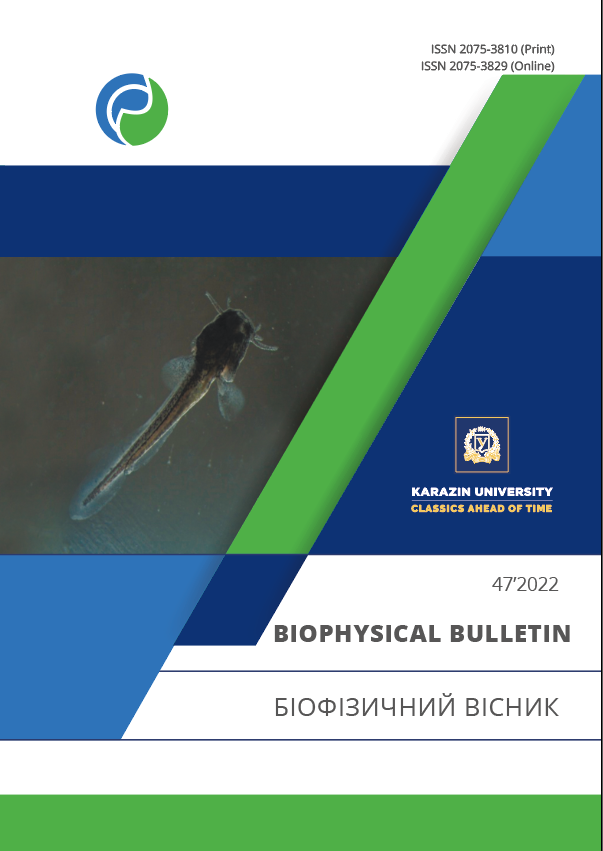Photomorphogenesis and content of carbohydrates in the axial organs of field pean seedlings under the influence of selective light
Abstract
Background: Light is a multifaceted exogenous factor that plays an important role in plant growth and development. The spectral composition of light is determinative for the regulation of photomorphogenetic processes in plants. Nowadays plants have several groups of photoreceptors that include receptors of red (RL) and far red light (FRL) — phytochromes; receptors of UV-A, blue (BL) and green (GL) light — cryptochromes, phototropins, proteins of the ZEITLUPE family, as well as the UV-B receptor — UVR8 protein. One of the possible mechanisms that realize an activation of photoreceptor systems in the plant may be concerned with carbohydrate metabolism. The research of morphogenetic reactions of seedlings under the action of selective light irradiation by activating photoreceptor systems is important for understanding the mechanisms of regulation of the program of plant organism`s ontogenesis.
The aim of this study was to investigate the effect of selective light of different spectrum: RL (660 nm), GL (530 nm) and BL (450 nm) on growth reactions, morphogenesis and content of soluble carbohydrate in axial organs of seedlings of long-day plants.
Materials and methods: 10-day etiolated seedlings of pea Maecenat variety were used for experiments. Activation of photoreceptor systems by red (RL, 660nm), green (GL, 530nm) and blue (BL, 450nm) light was performed for 5 days for 30 minutes using LED matrices. The growth reaction, morphogenesis and the content of soluble mono- and oligosugars in the axial organs of seedlings were analyzed.
Results: The axial organs of seedlings differ in their response to irradiation with selective light. The root system is more sensitive to the action of selective light than the shoot of the seedlings of the long-day plants of the pea Maecenat variety. Activation of photoreceptor systems stimulates growth processes, activates the processes of photomorphogenesis and the biosynthesis of oligosugars de novo, most likely sucrose. Among the spectra of selective light, the maximum stimulating effect is shown by irradiation of the GL (530 nm) in the reactions of the aboveground part and roots. RL (660 nm) and BL (450 nm) show opposite effects: RL initiates a photomorphogenetic program of shoot part, and BL has a greater effect on photomorphogenesis of root system.
Conclusions: Different levels of growth, morphogenetic processes and changes in the content of soluble carbohydrates are probably related to the ability of photoreceptor systems to activate the realization of different ways of photomorphogenesis in the axial organs of seedlings under the influence of selective light of a certain spectrum.
Downloads
References
Kami C, Lorrain S, Hornitschek P, Fankhauser C. Light-regulated plant growth and development. Curr Top Dev Biol. 2010;91:29–66. https://doi.org/10.1016/s0070-2153(10)91002-8
Quail PH. Phytochromes. Curr Biol. 2010; 20 (12): 504– 7. https://doi.org/10.1016/j.cub.2010.04.014
Voitsekhovskaja O V. Phytochromes and Other (Photo) Receptors of Information in Plants. Russ J Plant Physiol. 2019;66(3):163–77. https://doi.org/10.1134/S1021443719030154
Golovatskaya I P, Karnachuk R A. Role of green light in physiological activity of plants. Russ J Plant Physiol. 2015;62(6):727–40. https://doi.org/10.1134/S1021443715060084
Franklin KA, Quail PH. Phytochrome function in Arabodopsis development. J Exp Bot. 2010;61:11–24. https://doi.org/10.1093/jxb/erp304
Sakr S, Wang M, Dédaldéchamp F, Perez-Garcia M-D, Ogé L, Hamama L, Atanassova R. The Sugar-Signaling Hub: Overview of Regulators and Interaction with the Hormonal and Metabolic Network. Int J Mol Sci. 2018;19(9):2506. https://doi.org/10.3390/ijms19092506
Franklin K A, Whitelam GC. Phytochromes and shade-avoidance responses in plants. Ann Bot. 2005;96(2):169–75. https://doi.org/10.1093/aob/mci165
Fujii Y, Tanaka H, Konno N, Ogasawara Y, Hamashima N, Tamura S, Hasegawa S, Hayasaki Y, Okajima K, Kodama Y. Phototropin perceives temperature based on the lifetime of its photoactivated state. Proc Natl Acad Sci USA. 2017;114(34):9206–11. https://doi.org/10.1073/pnas.1704462114
Canamero С R, Bakrim N, Bouly J-P, Garay A, Dudkin E, Habricot Y, Ahmad M. Cryptochrome photoreceptors cry1 and cry2 antagonistically regulate primary root elongation in Arabidopsis thaliana. Planta. 2006;224(5):995–1003. https://doi.org/10.1007/s00425-006-0280-6
Christie J M, Blackwood L, Petersen J, Sullivan S. Plant flavoprotein photoreceptors. Plant Cell Physiol. 2015;56(3):401–13. https://doi.org/10.1093/pcp/pcu196
Eveland A, Jackson D. Sugars, signalling, and plant development. J Exp Bot. 2012;63(9):3367–77. https://doi.org/10.1093/jxb/err379
Baier M, Hemman G, Holman R, Corke F, Card R, Smith C, et al. Characterization of mutants in Arabidopsis showing increased sugar-specific gene expression, growth, and developmental responses. Plant Physiol. 2004;134(1):81–91. https://doi.org/10.1104/pp.103.031674
Zhmurko V V. [Photoperiodism of plants: physiological, biochemical and genetic aspects]. In: Morgun VV, editor. [Plant physiology: problems and prospects of development]. V. 1. Kyiv: [Logos]; 2009. P. 537–64. (in Ukrainian)
Ermakov A I, editor. [Methods of biochemical research of plants]. L: Agropromizdat Publ; 1987. 430 p. (in Russian).
Kuznetsov V V, Doroshenko A S, Kudryakova N V, Danilova M N. Role of Phytohormones and Light in De-etiolation. Russ J Plant Physiol. 2020;67:971–84. https://doi.org/10.1134/S1021443720060102
Kim J Y, Song J T, Seo H S. COP1 regulates plant growth and development in response to light at the post-translational level. J Exp Bot. 2017; 68 (17): 4737–48. https://doi.org/10.1093/jxb/erx312
Ivanov V B. Cellular mechanisms of plant growth. M: Nauka; 2011. 104 p. (in Russian)
Koch K. Sucrose metabolism: regulatory mechanisms and pivotal roles in sugar sensing and plant development. Curr Opin Plant Biol. 2004;7(3):235–46. https://doi.org/10.1016/j.pbi.2004.03.014
Authors who publish with this journal agree to the following terms:
- Authors retain copyright and grant the journal right of first publication with the work simultaneously licensed under a Creative Commons Attribution License that allows others to share the work with an acknowledgement of the work's authorship and initial publication in this journal.
- Authors are able to enter into separate, additional contractual arrangements for the non-exclusive distribution of the journal's published version of the work (e.g., post it to an institutional repository or publish it in a book), with an acknowledgement of its initial publication in this journal.
- Authors are permitted and encouraged to post their work online (e.g., in institutional repositories or on their website) prior to and during the submission process, as it can lead to productive exchanges, as well as earlier and greater citation of published work (See The Effect of Open Access).





